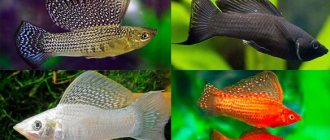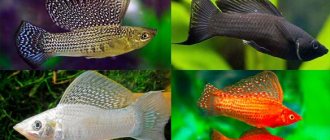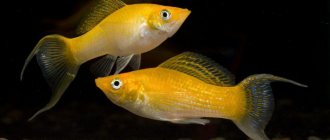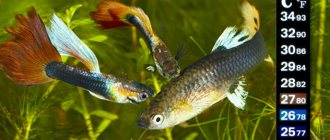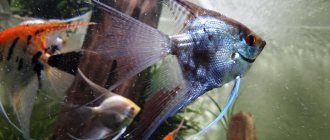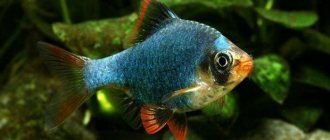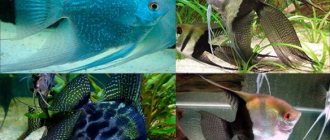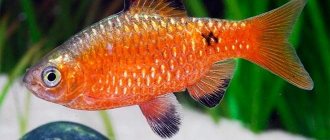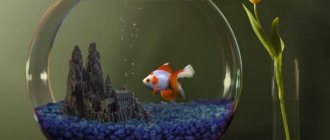Description of mollies fish
In appearance, mollies are closest to swordtails. The female molly is larger than the male; in some species, the female can reach 17 cm, and the males are almost half that size. Mollies are viviparous. The natural color of the fish is silver; there are yellowish or black spots on the body. The life of mollies in the wild is short - about three years.
The body of the fish is flattened and short, there are wide and strong fins. The back darkens in color, the color becomes almost white near the abdomen. Gender is determined by the shape of the anal fin.
Molliesia aquarium fish maintenance and care
For care and maintenance you will need:
- a spacious aquarium of at least thirty liters at the rate of 3 liters per individual;
- a sufficient amount of plant food for a two-week fish diet;
- a sufficiently lit place, the light from which shines on the aquarium for at least half a day;
- algae and gravel necessary to create a comfortable environment for the inhabitants;
- compressor and filter.
Aquarium characteristics
In order for mollies to feel comfortable and not get sick, they need a favorable habitat. Breeders advise setting up an aquarium of at least thirty liters. It is calculated that six liters is enough for two fish, which means that a 30-liter aquarium can contain schools of ten individuals - the larger the aquarium, the better. The fish are very active and love to frolic, so they like the space.
Mollies love fresh water - you need to focus on this and not let the liquid stagnate. The replacement must be systematic - once a week it is necessary to change a quarter of the volume of the aquarium, adding fresh, settled water. If you do this constantly, you can avoid increasing the concentration of nitrite, nitrate and ammonia.
The aquarium must have a filter and an oxygen compressor for uninterrupted air supply. Environmental indicators for mollies:
- acidity – 7.2-8.5;
- lighting intensity – 0.5-0.7 W/l;
- hardness – 10-35˚.
Fish usually swim in mid-waters and closer to the surface of the aquarium. For 12 hours, the aquarium should be illuminated with as much natural light as possible, so it is recommended to place it in open places. You shouldn’t pile a lot of decorative elements on the bottom. It is enough to pour a high-quality coating of stones and add more algae. Snags, castles and other shelters are kept to a minimum.
For maintenance, the optimal water temperature is considered to be from 22 to 30 degrees - mollies are heat-loving and do not tolerate hypothermia.
Feeding Mollies
Mollies are not whimsical fish; they eat the most common food, but it should be varied. You should not give only one type of food, for example, animal food; it is best to alternate live, dry and plant food. Pay attention to a sufficient amount of plant food, otherwise the fish will begin to eat the algae in the aquarium.
How long mollies live in captivity depends on the conditions of detention. It is important to create a biological balance of the environment so that the inhabitants experience their native environment as much as possible.
Maintenance and care
Content rules include:
- competent choice of aquarium;
- taking into account the required water characteristics (purity, temperature, hardness, acidity);
- soil properties and composition;
- presence of plants in the aquarium;
- length of daylight hours;
- the presence of filtration and aeration systems in the aquarium.
The best option for an aquarium is the classic one, when the width of the aquarium is equal to the height, and the length is one and a half or two times the height. The size of the container depends on two criteria:
- molly breeds;
- type of aquarium - general or species.
An aquarium with mollies
Due to the requirements that mollies make for living conditions, it is recommended to organize a species aquarium for these fish. Small species, for example, sphenops, will feel comfortable in a relatively small space - a 10-liter aquarium is quite enough for two fish (accordingly, for 10 sphenops, a 50-liter tank is suitable).
Large species need much larger volumes, for example, such a large platy like velifera requires a 20 or even 30 liter vessel for two adult individuals.
Note: All varieties of mollies are schooling fish, so you should immediately calculate the volume for several individuals.
All types of platies prefer well-purified water. Since mollies are heat-loving fish, the water temperature should be from 25 to 270C. The alkali content in water should be low - from 7 to 8.5.
Mollies live in both fresh and brackish water. In rare cases, fish are found even in sea water. Thus, it is advisable to add salt to the water in the aquarium (1-3 teaspoons of table salt is enough for 10 liters). Higher levels of salinity are achieved using sea salt or sea water.
Important! Water that is too salty is absolutely not suitable for freshwater fish and plants. This must be taken into account when creating a marine aquarium for mollies.
Since a saltwater aquarium requires complex care, it is recommended to keep the platies in fresh or slightly salted water.
Small pebbles or coarse gravel are ideal as soil. For light-colored breeds, a dark primer is recommended, against which they will look more impressive. For black varieties, on the contrary, light tones of the substrate are needed.
Representatives of the genus Mollies love to hide in dense thickets of aquatic vegetation. However, you shouldn’t get carried away with this: the presence of plants should not interfere with the free movement of fish in the aquarium. The most suitable place for arranging an underwater jungle is the back wall of the vessel. To decorate an aquarium, it is better to use plants such as:
- elodea;
- Vallisneria;
- pinnately.
Elodea
Each of them is unpretentious in terms of maintenance and care. Other more demanding species require comfortable conditions, namely: compliance with indicators of water hardness, temperature, salinity and acidity.
As for the duration of daylight hours, it should last 12 hours at a minimum. In this case, it is desirable that the mollies’ home be illuminated by natural sunlight for 2 hours a day.
Note: Lack of sunlight can lead to the development of infertility in male platies.
It is recommended to equip the aquarium with an aerator and a filtration system.
Caring for fish involves monitoring and maintaining all necessary water parameters at the required level. To prevent the accumulation of waste products in the aquarium, the water should be renewed once a week by 1/3 of the main volume. The physical and chemical parameters of fresh water (hardness, salinity, pH, temperature) should be the same as in the aquarium.
The fish must be fed daily.
Important! Pay attention to signs that indicate a bad situation in the aquarium. In particular, fish swimming near the surface of the water indicates a lack of oxygen or contamination with waste products. A low temperature is indicated by the behavior of fish in which they lie on the bottom or stand in one place, pressing their fins to their body. Thus, in the first situation, it is necessary to update a third of the water in the aquarium, and in the second case, adjust the operation of the thermostat.
Types of molly
Since mollies are one of the most common inhabitants of aquariums, several varieties of these fish have been bred. In nature you can find representatives of the following species:
- sail molly or velifera;
- sphenops;
- latipina (broadfin);
- Mexican.
There are two more species of fish - petena mollies and dwarf mollies, but they do not participate in crossing. If we talk about fish swimming in aquariums, then in most cases these are not representatives of natural forms, but hybrids - the results of crossing and their offspring. Therefore, it is difficult to believe that when selling you are buying a real latipina or velifera, and even more so to accurately distinguish a natural representative from a hybrid. Fish with a small fin are hybrids of Sphenops and the Mexican variety, but hybrids of Velifera, Latipin and Sphenops have larger fins.
Morphological variants of mollies primarily differ in color; there are black, yellow, white, red and spotted mollies . The black fish has small fins and pointed body contours. Yellow mollies with intense color on the back, but the abdomen lightens, turning to white.
White molly is a breeding velifera. Such a fish does not exist in nature; it is a color variant of selection. Snowflake, as the fish is called, has a body with a beautiful silvery tint, and the fins change from translucent at the base to almost transparent towards the end. When moving, such a fish looks very gentle, it seems to float on water.
Gorgeous fins on the red molly. It is rare in an aquarium, but you can find a spotted resident - such a mollies fish is called Dalmatian . Dalmatian A real decoration of any aquarium are lyretail mollies, which have a bright orange color and black fins with small light inclusions.
Conditions of detention
Even beginners can keep mollies in an aquarium, given the unpretentiousness and peaceful nature of these fish. It is better to house them in flocks of 7 - 10 pieces with a numerical advantage of females.
The volume of the aquarium is chosen based on the size and number of its inhabitants. For a flock of several mollies, it should have a capacity of 50 liters, at the rate of 10 liters per individual.
Given the active lifestyle of fish, they need space for free movement. It is better to choose a container with a classic, rectangular shape. A lid is required: pets can jump out of the water.
For mollies, the degree of illumination of the aquarium matters. They require bright light for 12 hours a day.
In addition to free space for active swimming, the aquarium should have places with dense thickets of algae, which the fish will use as shelter. The soil can be pebbles with medium-sized fractions.
Basically, these fish move in the middle and upper layers of the reservoir, which should be taken into account when equipping it.
Proper maintenance of mollies in an aquarium requires the following water characteristics:
- temperature - +24C -+27C;
- degree of hardness (GH) – 11 – 25;
- acidity level (pH) – 7.5 – 8.
In addition, you will need to organize a water aeration and filtration system, as well as weekly replacement of its fourth part.
Dissolving table or sea salt in water (2 g per 1 liter) will help ensure comfortable conditions for keeping mollies. But such measures are permissible if the neighbors are not other species of fish.
Young shoots of plants can be eaten, so the fish need plant nutrition.
Compatibility with other fish
Mollies are excellent neighbors, but you can keep only one species in an aquarium, but also with other fish . The fish do not conflict with each other, but it is better to have more female mollies in the school. If the aquarium is too small, the males may race each other, disturbing the peace of the others.
If you add other species to mollies, it is better to select representatives of the same size. Mollies have the best compatibility
- zebrafish;
- characins;
- ancistrus;
- guppy;
- catfish;
- gourami;
- irises.
You should not add tiger barbs and various varieties of cyclids to the aquarium - such species do not get along .
Compatibility with other fish
Mollies get along very well with swordtails, despite the restless behavior of the latter. It is important to consider several points here. Firstly, to prevent male swordtails from touching female mollies, there must be females in the flock of swordtails. Secondly, to avoid a “fight for territory”, the fish must feel free, and this requires a lot of space.
Black mollies
Almost perfect compatibility between platies and guppies. Both species are viviparous, prefer to live in warm, slightly salty water, love light and simply love to hide in the underwater jungle.
Mollies can also be kept together with fish such as:
- labeo;
- tetras;
- iris;
- catfish and all species of poeciliids.
Reproduction and sexual differences between male and female mollies
The production of offspring must be approached taking into account how mollies reproduce . The fish are viviparous fish. They do not spawn, but immediately give birth to viable fry. Females can produce offspring at the age of five to seven months, but for male mollies to be able to fertilize, it will take from nine months to a year. For reproduction, the water in the aquarium must be sufficiently warm and salty - these are ideal conditions for fish. You can add regular table salt - one tablespoon per 20 liters of water.
Signs on how to distinguish a female from a male . Female mollies are larger than males, in some varieties almost twice as large, so they are very easy to distinguish. A key marker for sexual differences is the shape of the fin. In females, the fin has a triangular shape, but in males it is rolled into a tube. The male fertilizes all the eggs at one time.
Signs of mollies pregnancy can be noticed after some time - the fish becomes pot-bellied, and a dark spot can be seen in the lower abdomen. The fish tries to hide in the corners of the aquarium and becomes less active. The fry are gestated for approximately 35-45 days, the first time pregnancy lasts as long as possible. For spawning, mollies are placed in a separate aquarium - a nursery.
How to prepare fish for breeding
During one birth of mollies, from 40 to 55 viable fry can appear, this process usually occurs in the morning. The emerging offspring are still weak and need careful care. In the nursery, the fry do not immediately begin to swim in the water; at first they lie down on the ground or in the algae.
After the babies are born, the female is returned back to the aquarium. The condition of the fish is monitored for some time, improved nutrition is given, and vitamins are added.
How to distinguish a female from a male molly?
Aquarium hobby attracts many people today. City apartments and even offices are decorated with aquariums. It is interesting to look at decorative fish in a small pond created in the apartment. When choosing fish, it doesn’t hurt to first find out in what conditions they can live. Many individuals have great sensitivity; maintaining them will require a lot of effort. It is easier to breed swordtails, guppies or mollies. Some aquarists, when breeding fish, do not know how to distinguish a male from a female.
Content
How to distinguish a male
For the last individual to live, it is necessary to create favorable conditions, because it has special sensitivity. Its natural environment is brackish, warm water bodies. Mollies like to hide behind plants, so the aquarium should have plenty of algae.
A naturalist can distinguish mollies by looking at how the anal fin is structured. Females have a round fin. In the male, this limb is rolled up into a tube, as can be seen in the photo. They can be distinguished by the formed sexual organ - the gonopodium.
How to distinguish a female
The difference between females is their size. It is unlikely to find a large male. But the male has a very bright coloring, and his body has large fins.
Mollies can be bred in normal conditions. It is not necessary to provide special conditions for this. The main thing is that the temperature in the aquarium is 22-30 degrees. Sudden changes are harmful for the fish. The water must be clean. It should not be allowed to bloom.
Instructions for determining the sex of mollies
- The fish are examined and their anal fin is found. You should look at the belly of the individual and find the anus. It is located next to the caudal unpaired fin. If the individual is female, then it has a triangular fin, if male, then the shape of the fin resembles a tube. With this fin, the individual performs internal fertilization, since the fish are viviparous. This sign is used to determine the sex of any viviparous fish.
- There are individuals of mollies that are distinguished by size. The male is smaller in size than the female. Males are more active. It talks about the ability of an individual to produce healthy offspring. The sailing species of mollies is different from the usual one.
- An adult male Mollienesia velifera has a huge sail-shaped dorsal fin, which is why this fish is called Sailfish: photo
The female specimen has the usual small dorsal fin.
When going to a store or market to buy fish, you need to be able to distinguish a girl from a boy, because the seller’s task is to sell his goods as quickly as possible, and he may not understand such issues. You can get a beautiful fish in an aquarium, but it must have the ability to reproduce.
Of course, who wouldn’t want to get a luxurious molly with paired fins in the form of large brushes. Only in this case it is difficult to distinguish a male from a female, because the paired fin will also end in a large brush. The same goes for the anal fin. This occurs because this fish was created from two species of individuals and is called Huppinesia. If you come across a fish like this in a store, you should know that it is sterile and not suitable for breeding.
Gender of the fry
When the fry is just born, regardless of what gender it is, its anal fin is straightened and it is impossible to determine unambiguously whether it is a male or a female. The sex of the fry becomes distinguishable from the end of the first to the beginning of the third month of life.
Molly fry are translucent, 6–7 mm in size. After birth, they do not immediately swim; they lie at the bottom of the aquarium for some time. Newborns are separated from other fish, even from their mothers, so that they are not eaten by adult viviparous fish.
HOW TO DISTINGUISH A FEMALE FROM A MALE TERNITY?
HOW TO BREED TERNATIONS AT HOME
BOTIA: TYPES, CONTENT, COMPATIBILITY, BREEDING, PHOTO, VIDEO, FEEDING
HOW TO DISTINGUISH A FEMALE FROM A MALE ALGAE EATER?
HOW TO DISTINGUISH A FEMALE FROM A MALE NEON?
Caring for fry
The fry require special care because they are very susceptible to external conditions. In the aquarium where the released offspring are located, the water must be changed frequently to avoid stagnation. To increase the immunity of the fry, it is recommended to add a little salt to the water.
In order for the fry to gain weight and grow, it needs high-quality food. You can use both live food and plant food, but small. Dry food should be crushed to the consistency of dust. It is also recommended to use special food for fry, enriched with vitamins - they can be purchased at a pet store. The feeding schedule is frequent (every 2-3 hours) and plentiful.
What to feed
You can feed the fry a wide variety of foods. There are no special preferences in this regard, but the most important criterion for feeding what to feed molly fry is nutritional value and the presence of vitamins. This is a prerequisite for the growth of baby mollies. The diet of the fry includes crushed food, live dust, cyclops, and artemia nauplii. Daphnia moina, vinegar eel and aulophorus are excellent to eat.
How long do they grow?
If the fry are fed properly and excellent conditions for raising offspring are provided, then you can expect rapid growth of the babies. In just three to four weeks, the crumbs will reach 2-2.5 cm. Mollies mature at 4-5 months.
How to grow
The temperature in the aquarium where the babies are placed should be at least 27-29 degrees. It is strictly forbidden to lower the water temperature, because in this case the mollies fry will experience hypothermia and die. Sensitivity to temperature is the main problem when raising born molly offspring.
When mollies reach 2.5 cm in length, they can be transplanted into an aquarium with adults. They do this carefully, first releasing three or four fish. If they were treated friendly, and other fish do not pursue the newcomers, then you can release the rest.
Mollies diseases
Mollies cannot be called a very fastidious fish. With proper care, the resident of the aquarium does not get sick and pleases the owner with his activity. However, the fish are susceptible to some ailments - they are very easy to notice by the decrease in the activity of the always contact mollies. In most cases, changes in behavior are caused by improper keeping of pets. We list the most common diseases and descriptions of symptoms:
- ammonia poisoning - an aquarium fish often opens its mouth and swallows air from the surface or, on the contrary, leans towards the pebbles, tail up;
- melanosis - the body of the fish becomes covered with spots, which soon turn into tumors; this disease cannot be treated, and the pet dies;
- Columnaria is a bacterial infection that manifests itself as plaque on the lips and resolution of the caudal fin;
- hypothermia - the fish hangs in one place or presses itself to the bottom, rarely and extremely lazily moves its fins;
- infection by parasites - manifested by the appearance of growths or spots on the body of the fish, and the fish can also rub its belly on the surface of the bottom;
- gas embolism - occurs due to the addition of unsettled water, the fish in this case becomes too restless, its gills darken;
- mycosis - the manifestation on the body of a fish of peculiar fibrous formations, like pieces of cotton wool.
